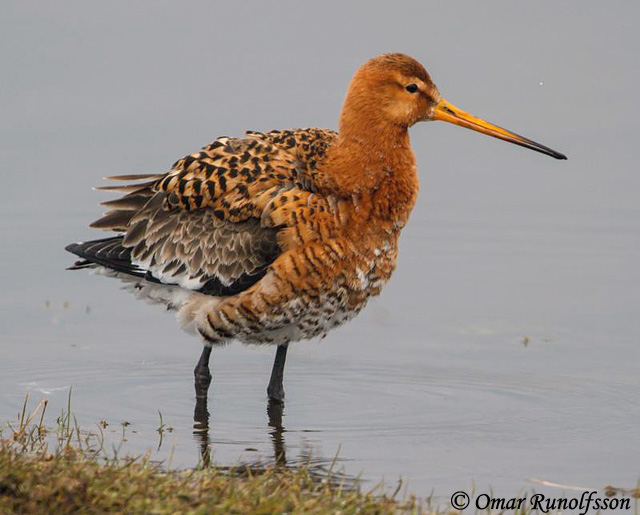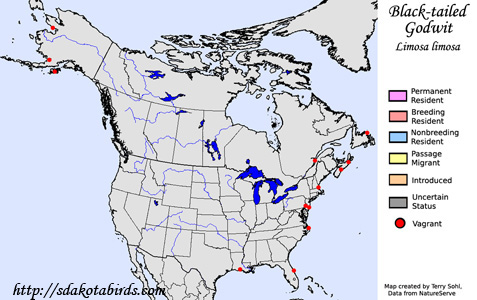| Length: 16 inches | Wingspan: 30 inches | Seasonality: Non-resident in South Dakota |
| ID Keys: Long upcurved bill, plain gray body on adult non-breeding birds, breeding males barred below with bright rufous on head, upper back, and breast. Breeding females similar plumage pattern, but much duller. | ||
 The
Black-tailed Godwit is the rarest of the Godwits in North America, as they
are only rare visitors from Eurasia. They breed in many parts of
Europe and Asia, and winter in Africa, the Middle East, southeast Asia, and
the Australia region. Most sightings of the Black-tailed Godwit in North
America have been in Alaska, and they may be regular migrants in the outer
Aleutians, but sightings have also occurred along the east coast and even in
some interior states in the United States.
The
Black-tailed Godwit is the rarest of the Godwits in North America, as they
are only rare visitors from Eurasia. They breed in many parts of
Europe and Asia, and winter in Africa, the Middle East, southeast Asia, and
the Australia region. Most sightings of the Black-tailed Godwit in North
America have been in Alaska, and they may be regular migrants in the outer
Aleutians, but sightings have also occurred along the east coast and even in
some interior states in the United States.
Habitat: Found in bogs, wet meadows, and moorlands in Eurasia during the summer breeding season. Similar wetland and damp habitats are used in migration and in the winter. They are most often found in areas of freshwater, but can also sometimes be found in brackish water environments.
Diet: Feeds on insects, insect larvae, and other invertebrates. They often feed on worms and mollusks on their wintering grounds. They will also sometimes feed on snails, small fish, or small amphibians
Behavior: Foraging is often done in shallow water, where they will probe the bottom for invertebrates. They will also sometimes feed on land, probing muddy areas with their bill or picking up food items directly from the surface.
Nesting: Breeds in loose colonies. The nest is a depression in the soil, lined with lichens, grasses, moss, or other vegetation. The female lays between 3 and 6 eggs, and both parents help to incubate them. When the eggs hatch, the young leave the nest almost immediately, and find their own food. However, both parents tend to the young and protect them from harm.
Interactive eBird Map: Click to access an interactive eBird map of Black-taield Godwit sightings
Song: Flight call is a weeka-weeka-weeka.
Migration: Migratory. The Black-tailed Godwit breeds in many scattered, discontinuous locations in Europe and Asia. Wintering grounds for individual populations vary, but includes areas of far southwestern Europe, Africa, the Middle East, southeast Asia, or Australia and surrounding areas.
Similar Species: Bar-tailed Godwit, Hudsonian Godwit
Conservation Status: Populations of the Black-tailed Godwit are still relatively large, and they are found over a wide geographic area. However, their numbers are declining very sharply, and the IUCN lists the Black-tailed Godwit as a "Near Threatened" species.
Further Information: 1) ARKIVE.org - Black-tailed Godwit
2) BirdLife International - Black-tailed Godwit
3) Black-tailed Godwit - Journey of a Bird Under Threat
Photo Information: Photo taken by Omar Runolfsson - May 11th, 2012 - Iceland - Photo licensed under Creative Commons Attribution 2.0 Generic License.
| Click below for a higher-resolution map |
 |
| South Dakota Status: Non-resident in South Dakota |
Additional Black-tailed Godwit Photos (coming soon!!)
